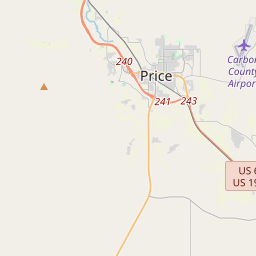Abraham Powell 1877 Cabin
Historical marker location:
Price, Utah
Marker installed: 2011







© OpenStreetMap contributors
Loading...
Searching for other points of interest within 3 miles of this location.The state's name comes from the Ute tribe, who were the original inhabitants of the region. The word "Ute" means "land of the sun" or "people of the mountains."
About Carbon County
Carbon County Timeline
Carbon County, Utah, has a rich history that dates back thousands of years. The area was originally inhabited by various Native American tribes, including the Ute and the Paiute. These tribes utilized the abundant natural resources in the region, such as water from the rivers and streams, as well as the diverse plant and animal life for sustenance.
In the 1800s, European settlers began to venture into Carbon County. The discovery of coal in the area in the late 1800s marked a significant turning point. Coal mining quickly became a major industry in the region, attracting thousands of immigrants seeking work and opportunities. The development of the coal industry brought rapid growth and urbanization to Carbon County.
The early 20th century saw Carbon County flourishing as a coal mining hub. The county's population soared, and numerous mining towns sprung up, including Helper, Sunnyside, and Castle Gate. These towns were bustling, with schools, businesses, and recreational facilities catering to the coal miners and their families. Immigrants from various countries, including Greece, Italy, and Wales, flocked to Carbon County, adding to its vibrant cultural diversity.
However, the coal industry in Carbon County faced numerous challenges over the years, including labor strikes and economic downturns. The decline of coal mining in the latter half of the 20th century had a significant impact on the region's economy and population. Nevertheless, Carbon County has continued to adapt and diversify its industries, with a focus on tourism, outdoor recreation, and renewable energy in recent years. Today, the county's rich history is preserved through museums, historic sites, and a vibrant local community.
In the 1800s, European settlers began to venture into Carbon County. The discovery of coal in the area in the late 1800s marked a significant turning point. Coal mining quickly became a major industry in the region, attracting thousands of immigrants seeking work and opportunities. The development of the coal industry brought rapid growth and urbanization to Carbon County.
The early 20th century saw Carbon County flourishing as a coal mining hub. The county's population soared, and numerous mining towns sprung up, including Helper, Sunnyside, and Castle Gate. These towns were bustling, with schools, businesses, and recreational facilities catering to the coal miners and their families. Immigrants from various countries, including Greece, Italy, and Wales, flocked to Carbon County, adding to its vibrant cultural diversity.
However, the coal industry in Carbon County faced numerous challenges over the years, including labor strikes and economic downturns. The decline of coal mining in the latter half of the 20th century had a significant impact on the region's economy and population. Nevertheless, Carbon County has continued to adapt and diversify its industries, with a focus on tourism, outdoor recreation, and renewable energy in recent years. Today, the county's rich history is preserved through museums, historic sites, and a vibrant local community.
Carbon County Timeline
This timeline provides a condensed summary of the historical journey of Carbon County, Utah.
- 1850s - Indigenous peoples inhabit the region now known as Carbon County.
- 1877 - The first coal mine in Carbon County, known as the Pleasant Valley Coal Company, is established.
- 1879 - The community of Price is founded.
- 1892 - Carbon County is officially established by the Utah State Legislature.
- 1900s - Mining operations expand in Carbon County, leading to a population boom.
- 1912 - The Denver and Rio Grande Western Railroad connects Carbon County to the national rail network.
- 1924 - The town of Helper is incorporated.
- 1930s - Carbon County experiences economic hardship during the Great Depression.
- 1942-1946 - The U.S. government builds the Geneva Steel Plant in nearby Utah County, providing employment opportunities for Carbon County residents.
- 1980s - Carbon County's coal industry experiences a decline, resulting in job losses and economic challenges.
- 2000s - Tourism becomes an important industry in the region, with attractions like the Helper Historic District and the Carbon County Event Center.